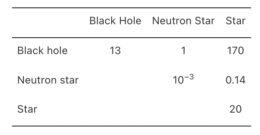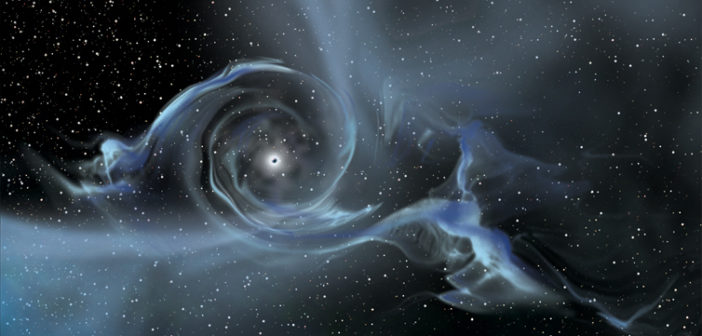At the heart of some galaxies, a disk of gas whirls around a central supermassive black hole. A recent publication explores what might happen when stars and stellar-mass black holes meet in the disks around supermassive black holes.
Getting an Assist from an Active Galactic Nucleus

Simulated orbital evolution of four stars orbiting an active galactic nucleus. This plot shows how the orbital semimajor axis (top), eccentricity (middle), and angle between the stellar orbit and the disk rotation axis (bottom) change over time. [Yang et al. 2022]
Once the stars are settled in the disk, they migrate inward and become susceptible to gravitational entanglements with other objects. Some of these stars will link up with stellar-mass black holes to form binary systems. From there, astronomers predict that the orbits of these binaries shrink until the black hole’s tidal forces rip the star apart, causing a small-scale version of the same phenomenon that occurs around supermassive black holes: a tidal disruption event (TDE). But how common are these theorized micro-TDEs likely to be, and what observational signatures would they have?

Estimated rates of different types of binary mergers or disruptions within the disk surrounding an active galactic nucleus. Results are in units of events per cubic gigaparsec per year. Micro-TDEs refer to interactions between stars and stellar-mass black holes. [Yang et al. 2022]
Event Estimation
A research team led by Yang Yang (University of Florida) estimated the frequency of these events as well as the kind of electromagnetic signals they would emit. The team began by estimating how many stars and black holes will end up in aligned orbits within the disk of an active galactic nucleus. From there, the authors applied a random distribution of masses to the stars and black holes and calculated how quickly binary systems assembled from these populations would merge, resulting in a rate of one event per year per cubic gigaparsec (1 cubic gigaparsec = 3.5×1028 cubic light-years; about 50,000 times the volume of the Virgo Supercluster).
As to what kind of electromagnetic signals these events might produce, Yang and collaborators suggest that they would resemble the signals from TDEs around supermassive black holes — but with some key differences. The stream of accreted material that forms around a stellar-mass black hole will be hotter than the stream that forms around a supermassive black hole, producing copious X-ray emission, and micro-TDEs may reach their peak luminosity later than full-scale TDEs.
Disruption Detection

An artist’s impression of a tidal disruption event. [NASA’s Goddard Space Flight Center]
At present, two candidate events have been discovered, though the authors can’t rule out the possibility that they are regular TDEs. As with any as-yet-unobserved phenomenon, more theoretical work is needed to ensure we’ll be able to identify micro-TDEs when we find them.
Citation
“Tidal Disruption on Stellar-mass Black Holes in Active Galactic Nuclei,” Y. Yang et al 2022 ApJL 933 L28. doi:10.3847/2041-8213/ac7c0b
